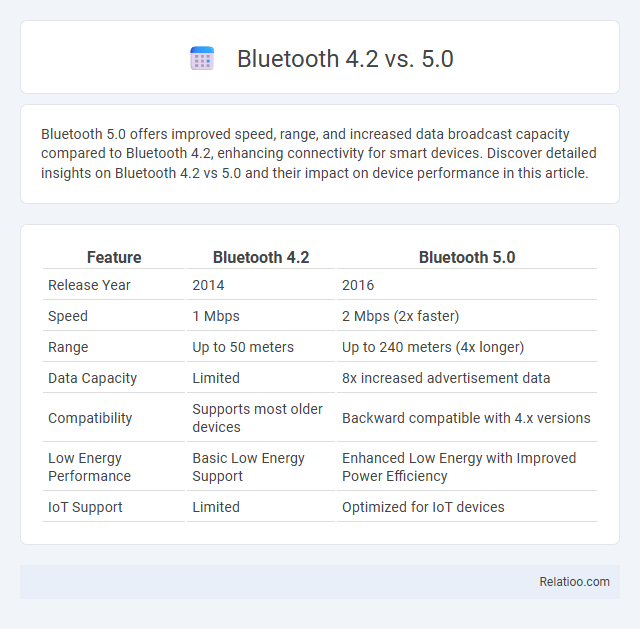Bluetooth 5.0 offers improved speed, range, and increased data broadcast capacity compared to Bluetooth 4.2, enhancing connectivity for smart devices. Discover detailed insights on Bluetooth 4.2 vs 5.0 and their impact on device performance in this article.
Table of Comparison
| Feature | Bluetooth 4.2 | Bluetooth 5.0 |
|---|---|---|
| Release Year | 2014 | 2016 |
| Speed | 1 Mbps | 2 Mbps (2x faster) |
| Range | Up to 50 meters | Up to 240 meters (4x longer) |
| Data Capacity | Limited | 8x increased advertisement data |
| Compatibility | Supports most older devices | Backward compatible with 4.x versions |
| Low Energy Performance | Basic Low Energy Support | Enhanced Low Energy with Improved Power Efficiency |
| IoT Support | Limited | Optimized for IoT devices |
Introduction to Bluetooth 4.2 and 5.0
Bluetooth 4.2 introduced improved speed, enhanced privacy features, and increased data transfer capacity with a maximum speed of 1 Mbps operating typically at 2.4 GHz frequency. Bluetooth 5.0 significantly advanced wireless connectivity by doubling the speed to 2 Mbps, quadrupling the range up to 240 meters, and improving coexistence with other wireless technologies, all while maintaining the same 2.4 GHz frequency band. Understanding these differences helps You optimize device compatibility and performance in applications requiring reliable and efficient Bluetooth connections.
Key Differences in Speed and Data Rate
Bluetooth 5.0 offers significant improvements over Bluetooth 4.2 in speed and data rate, with a maximum data rate of 2 Mbps compared to 1 Mbps in Bluetooth 4.2, effectively doubling the transfer speed. The frequency range remains the same at 2.4 GHz for both versions, but Bluetooth 5.0 utilizes enhanced modulation techniques to increase efficiency and range. Your devices will benefit from faster data transfer and more robust connections when upgrading to Bluetooth 5.0 technology.
Range Improvements: How Far Can They Go?
Bluetooth 4.2 operates primarily on the 2.4 GHz frequency band, offering a maximum range of approximately 10 meters, suitable for most personal area network devices. Bluetooth 5.0 also uses the 2.4 GHz band but introduces enhanced features like increased transmit power and improved data coding schemes, extending its range up to 240 meters in open space. These range improvements in Bluetooth 5.0 make it ideal for applications requiring longer-distance connectivity without compromising energy efficiency.
Energy Efficiency and Power Consumption
Bluetooth 5.0 significantly improves energy efficiency and reduces power consumption compared to Bluetooth 4.2 by enabling longer range and faster data transmission at lower energy costs. The 2.4 GHz frequency band used by both versions supports low-energy operations, but Bluetooth 5.0 optimizes power bursts and adaptive frequency hopping to minimize interference and power use. Your devices benefit from extended battery life and more stable connections when upgrading to Bluetooth 5.0 technology.
Enhanced Security Features
Bluetooth 5.0 offers significant improvements over Bluetooth 4.2, including enhanced security features such as stronger encryption algorithms and improved privacy controls through MAC address randomization. Operating primarily in the 2.4 GHz frequency band, Bluetooth 5.0 also supports longer range and faster data rates, reducing vulnerability to hacking and eavesdropping compared to earlier versions. Your devices benefit from these advancements by ensuring more secure and reliable connections, protecting sensitive information during wireless communication.
Connectivity and Device Pairing
Bluetooth 5.0 offers significant improvements over Bluetooth 4.2 in connectivity range, extending up to 240 meters compared to 60 meters, enhancing device pairing stability in larger environments. Both versions operate primarily on the 2.4 GHz frequency band, but Bluetooth 5.0 optimizes frequency hopping mechanisms to reduce interference and improve signal reliability. Enhanced pairing protocols in Bluetooth 5.0 enable faster and more secure connections, supporting multiple device pairings simultaneously without losing connection quality.
Compatibility with Older Devices
Bluetooth 4.2 offers solid compatibility with older devices operating on previous Bluetooth versions, ensuring seamless connections for most everyday use. Bluetooth 5.0 enhances compatibility by supporting both backward connectivity and improved frequency range, allowing your devices to maintain stronger connections over longer distances. Frequency differences allow Bluetooth 5.0 to operate more efficiently in congested environments, providing a better user experience without sacrificing support for legacy devices.
Audio Performance and Features
Bluetooth 5.0 offers significant improvements over Bluetooth 4.2 in audio performance, including enhanced data transfer rates and increased range, which result in clearer sound quality and reduced latency for your wireless audio devices. Bluetooth 4.2 operates primarily on the 2.4 GHz frequency, limiting bandwidth, while Bluetooth 5.0 leverages the same frequency with better modulation and supports longer range and higher throughput, crucial for high-fidelity audio streaming. Your listening experience benefits from Bluetooth 5.0's advanced features like improved coexistence with other wireless technologies and better support for LE Audio, enhancing overall audio quality and connectivity stability.
Applications and Use Cases
Bluetooth 5.0 enhances applications with increased range up to 240 meters, higher data transfer speeds of 2 Mbps, and improved broadcasting capacity compared to Bluetooth 4.2, which operates primarily at 2.4 GHz with a limited range of about 60 meters. Bluetooth 4.2 suits low-energy applications such as fitness trackers and basic IoT devices, while Bluetooth 5.0 supports advanced use cases like smart home automation, location services, and reliable audio streaming due to its improved frequency management and signal robustness. The frequency band remains at 2.4 GHz for both versions, but Bluetooth 5.0's optimized modulation techniques enable better interference avoidance and energy efficiency across wireless applications.
Which Bluetooth Version Should You Choose?
Bluetooth 5.0 offers significant improvements over Bluetooth 4.2, including four times the range, twice the speed, and eight times the data broadcasting capacity, making it ideal for devices needing reliable long-distance connections and faster data transfer. Bluetooth 4.2 operates primarily on the 2.4 GHz frequency, while Bluetooth 5.0 also uses 2.4 GHz but optimizes its frequency-hopping capabilities to reduce interference and improve overall performance. You should choose Bluetooth 5.0 for enhanced range, speed, and connectivity, especially if your devices support the latest technology and require efficient data transmission over greater distances.

Infographic: Bluetooth 4.2 vs 5.0
 relatioo.com
relatioo.com